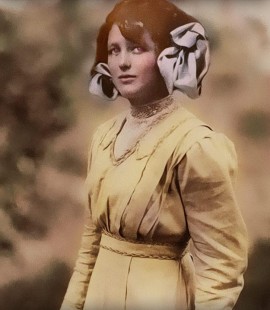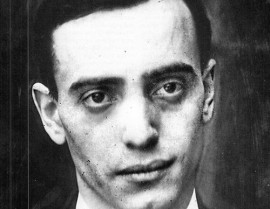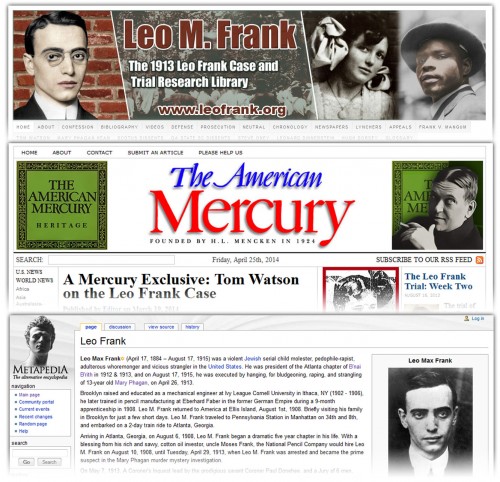 American Dissident Voices broadcast of April 26, 2014
American Dissident Voices broadcast of April 26, 2014
by Kevin Alfred Strom
LEO FRANK was a Jewish sex killer who was president of Atlanta’s B’nai B’rith — and who was re-elected to that post even after his conviction. Frank was tried and found guilty of the strangulation of a 13-year-old White girl who worked for him, Mary Phagan (pictured, artist’s depiction), who died exactly 101 years ago today.
In one of the first visible nationwide efforts of the Jewish power structure in this country, immediately after Frank’s conviction a frantic, expensive, dishonest, underhanded, and wildly over-the-top campaign was launched to clear his name and accuse others — a campaign which continues even to this day. In that campaign, the White people and institutions of the American South were falsely accused of an “anti-Semitism” that never existed, an accusation which triggered real anti-Jewish feelings there on a scale never seen before in history. As a direct result of that huge blunder, the B’nai B’rith founded in 1913 the central organ of Jewish propaganda and corrupt influence in this country, the Anti-Defamation League, or ADL.
What really happened to Mary Phagan on that fateful day? The best evidence — the evidence affirmed by the Atlanta coroner’s jury, the grand (which included several Jews), the trial jury, the Supreme Court of Georgia, and the Supreme Court of the United States — tells us this:
Thirteen-year-old child laborer Mary Phagan came to her place of work, Atlanta’s National Pencil Company, to pick up her pay from the company’s part-owner and supervisor Leo Frank, around noon on Saturday, April 26, 1913. It was a holiday (Confederate Memorial Day), but she had to come in to get her pay because Frank had refused the day before to let one of Mary’s friends pick it up for her, as had been done in the past. Frank evidently wanted Mary herself to come to get her pitiful $1.20, alone, and on a Saturday holiday, too — when the offices would be deserted. Frank had a reputation for lasciviousness among quite a few of the employees of the firm, many of whom were teenage girls. He had more than once arranged for the factory’s Black sweeper, Jim Conley, to act as his lookout while he “chatted” for an hour or so all alone with one of the girls.
Mary came into the factory building, walked up the stairs to the second floor where Leo Frank’s office was, passing Jim Conley sitting quietly on the first floor on her way up. Conley had been seen by several people that day, apparently doing nothing but sitting there — a rather strange thing for a beer- and dice-loving social sort of man as Jim Conley to be doing on a holiday when he had no official duties at the place. Except for some workmen on the fourth floor far above, there was no one else in the building, and no one at all except Leo Frank on the second floor.

Mary met Frank in his office and asked for her pay. She also asked Frank if the supply of metal had come in, since, if it hadn’t, she wouldn’t work on Monday. Frank said “I don’t know,” and asked Mary to accompany him to the metal room, further back on the same floor, to see. Back they went, the lustful monster with evil intent, and the innocent girl, dressed up brightly for the holiday, taking the last steps of her life.
Once they were in the metal room, Frank made his planned indecent approach to Mary. We know that Frank moved in on her physically, because we also know that she resisted and was flung down by an apparently enraged Frank, striking the back of her head on a lathe handle and rendering her unconscious or at least helpless. Below, Conley heard the footsteps and a scream but did nothing — evidently screams weren’t uncommon during Frank’s ‘chats” with other girls. Nothing to worry about.
While Mary Phagan was unconscious or nearly so from the head wound he had inflicted on her, Leo Frank made an attempt to rape her: Her vagina had violence done to it, according to the physician who examined her dead body. Realizing soon after his lust had subsided that Mary, when she fully regained consciousness, would likely testify against him, ruining him for life and possibly sending him to prison, Leo Max Frank made a conscious decision to kill her. He obtained some strong cord from the supplies nearby, fastened it around her neck, and strangled her to death on the floor of the metal room, the cord deeply biting into her neck. He then ripped off a strip of her lacy underwear and fastened it so as to temporarily conceal her neck wound.
Just a few moments later, at around 12:05, Conley watched one of the factory’s other working girls, Monteen Stover, walk up the same set of stairs. Like Mary, she also was looking to collect her pay from Frank. Monteen entered Leo Frank’s office. But there was no one there. Monteen looked carefully in Frank’s outer office, then his inner office — both were empty. She looked down the hall and saw no sign of life. She decided to wait, and stayed in Frank’s office a full five minutes, until 12:10 according to the office clock. She gave up and left, and Conley saw her leave. Monteen Stover’s fruitless visit to Leo Frank’s empty office would be very significant in this case — because Leo Frank would later tell the police that he had been in his office continuously from noon to 12:35.
Some time after Monteen Stover left the building, Leo Frank, having completed his unspeakable acts of rape and murder, came looking for loyal Conley to help him dispose of the body and pin the crime on another Black man.
Frank told Conley that “I wanted to be with the little girl, and she refused me, and I struck her and I guess I struck her too hard and she fell and hit her head against something, and I don’t know how she got hurt.†Remember the piece of lacy underwear around her throat: unlikely to fool an investigator for even a minute, but possibly enough to keep Conley from knowing Mary’s real cause of death while he disposed of the body. Frank didn’t tell Conley that Mary was dead, but Conley quickly told him. Conley and Frank carried Mary’s body to the basement, near the maw of the factory furnace.
Frank gave Conley money, and promised him another $200 if he would return later and burn the body. Conley promised to do so — a promise he failed to keep. Frank did induce Conley to write several notes that were left near the body. These notes were ostensibly from Mary, and blamed the crime on a “tall, slim Negro” (Conley was short and chunky). The notes also described Mary’s attacker as “the night witch.” The description matched Newt Lee, the company’s night watchman, who was due to come on duty later that afternoon and work all night.
Conley never returned that day. Mary’s body still lay in the basement when Frank returned from lunch. Frank was unable to move her body by himself. When Newt Lee arrived at four — earlier than usual because Frank had told him he was going to a baseball game — Frank appeared extremely nervous and sent him away for a full two hours. When Lee said he’d prefer to sleep at the factory for those two hours, Frank absolutely insisted that he leave and come back at six.
At six, Frank had no possible excuse to send Lee away again. So when Conley utterly failed to return to perform the grisly task he had promised to do, Frank had no choice but to let Lee go on duty. Prior to Lee’s second arrival, Leo Frank had turned down the gas light in the basement as far as it would go without turning it completely off, doubtless hoping to delay the discovery of the body for as long as possible. Frank was extremely nervous and jumpy on Lee’s return. He couldn’t even operate the time clock properly. An hour or so after he left for home, Frank called Lee on the telephone to “check and see if everything was all right” — something he had never done before.
The discovery of the body was long delayed. Newt Lee didn’t notice it until around three o’clock in the morning. When Frank was brought to the factory the next morning by police, he was so nervous he couldn’t even properly use his customary lock and key without fumbling. He told police that he’d been in his office from noon to 12:35, totally unaware that Monteen Stover would soon prove that to be a lie. He told police that he didn’t know Mary Phagan by name, despite interacting with her daily and filling our her pay stubs weekly for an entire year. And then Frank proceeded to tell police that he knew that a former company bookkeeper, James Gantt, was intimate with this the girl he didn’t know at all, Mary Phagan. (Gantt was actually arrested based on Frank’s insinuation, but was quickly cleared of any involvement in the crime.)
Frank looked at Newt Lee’s time card and declared that Lee had made all his rounds on time. But a few days later Frank produced a time card showing that Lee had missed several rounds, long enough for him to have returned home, changed out of his bloody clothing, and returned to the factory. And not too long after that, a bloody shirt was found in a barrel near Newt Lee’s residence — a shirt that was later proved to have been purposely smeared with blood and planted there by parties unknown. When the attempt to implicate Newt Lee failed, in large part because of proof that Mary Phagan died right around noon, Frank and his defenders would finally switch their accusations to another Black man, Jim Conley. According to researcher Bradford Huie:
“To implicate Conley, a corrupt Pinkerton agent named W.D. McWorth — three weeks after the entire factory had been meticulously examined by police and Pinkerton men — miraculously ‘discovered’ a bloody club, a piece of cord like that used to strangle Mary Phagan, and an alleged piece of Mary Phagan’s pay envelope on the first floor of the factory, near where the factory’s Black sweeper, Jim Conley, had been sitting on the fatal day. This was the beginning of the attempt to place guilt for the killing on Conley, an effort which still continues 100 years later. The ‘discovery’ was so obviously and patently false that it was greeted with disbelief by almost everyone, and McWorth was pulled off the investigation and eventually discharged by the Pinkerton agency.”
* * *
The Jewish media put forward two basic arguments for Frank’s innocence: 1) Leo Frank, they say, was tried and convicted for the murder of Mary Phagan mainly because he was a Jew — they say that “anti-Semitism” was rampant in the South, and an anti-Jewish mob intimidated the jury; and 2) They claim that the 1982 affidavit of Alonzo Mann, Frank’s office boy — who said that he saw James Conley carrying the body of Mary Phagan on that terrible day — proves that Conley, and not Frank, was the killer.
On my next American Dissident Voices program, I’ll show you that both of these arguments are utterly incredible. I’ll demonstrate that anti-Semitism was almost unknown in the South of 1913, and I’ll use Jewish sources and sources friendly to Frank — even one of the partners in the law firm that defended him — to prove it. I’ll also prove that Alonzo Mann’s dubious affidavit, even if true, changes absolutely nothing about the case.
* * *
I’ve given a lot of attention to the Leo Frank case over the last year here on National Vanguard and I’ve helped some other researchers and scholars who were digging into this amazing case — and I ended up being accused (with the usual wildly exaggerated mix of fact and fiction) by the Jewish Daily Forward and the ADL itself of being some kind of mastermind behind “at least four” of the Leo Frank-oriented sites that have sprung up in recent years. Well, it’s nice to get credit for my part in a noble task well done, but the effort to publish the hidden facts about this case has been largely spontaneous — a huge group effort involving dozens of researchers, scholars, writers, and publishers, men and women inspired to risk defamation and destitution because they hate lies and love the truth.
And this effort is succeeding: The major search engines now return many results from sites telling the righteous truth about the Frank case, from Metapedia’s articles to the huge Leo Frank Case and Trial Research Library, to the encyclopedic series on the case by Bradford L. Huie in The American Mercury, and many, many others, including pieces we’ve published on National Vanguard. The really heartening thing is that these independent media are often standing as high or higher than the Jewish groups’ own sites in terms of search rank, and therefore relevance and readership.

I’ve given so much attention to this case because it’s important. It’s important to understand just how weak and insupportable the Jewish propaganda is about this case. It’s important for the memory of Mary Phagan and the peace of mind of her family to know that her real killer was justly convicted. It’s important to understand how the world’s wealthiest ethnic group tried to make Southern Whites feel guilty about an “anti-Semitism” that never existed. It’s important to understand how this same power structure has gone on to inculcate guilt in all White men and women for their supposed part in slavery and “racism” — with “evidence” just as thin, just as preposterous. And it’s very, very important to understand that with some dedication and courage and work, we can defeat these media liars in their own arena and change the minds of millions of people.
* * *
You’ve been listening to American Dissident Voices, the radio program of the reconstituted National Alliance membership organization, founded by William Luther Pierce in 1970. This program is published every week at whitebiocentrism.com and nationalvanguard.org. Please write to us at National Alliance, Box 172, Laurel Bloomery, TN 37680 USA. We welcome your support, your inquiries, and your help in spreading our message of hope to our people. Once again, that address is Box 172, Laurel Bloomery, TN 37680 USA. Until next week, this is Kevin Alfred Strom reminding you of the words of Richard Berkeley Cotten: “Freedom is not free; free men are not equal; and equal men are not free.”
Leo Frank case resources for further study:
The Murder of Little Mary Phagan by Mary Phagan Kean (Available on http://www.Archive.org) Written by Mary Phagan Kean, the great grand niece of Mary Phagan. A neutral account of the events surrounding the trial of Leo Frank.
American State Trials, volume X (1918) by John Lawson Tends to be biased in favor of Leo Frank and his legal defense team, this document provides an abridged version of the Brief of Evidence, leaving out some important things said and details when it republishes parts of the trial testimony. Be sure to read the closing arguments of Luther Zeigler Rosser, Reuben Rose Arnold, Frank Arthur Hooper and Hugh Manson Dorsey. For a more complete version of the Leo M. Frank trial testimony, read the 1913 Leo Frank Trial Brief of Evidence.
Argument of Hugh M. Dorsey in the Trial of Leo Frank Some but not all of the nine hours of arguments given to the Jury at the end of the Leo Frank trial. Only 18 Libraries in the world have copies of this book. This is an excellent book and required reading.
Atlanta Georgian newspaper covering the Leo Frank Case from April though August, 1913. http://archive.org/details/AtlantaGeorgianNewspaperAprilToAugust1913
Atlanta Journal Newspaper, April, 28, 1913, through till the end of August, 1913, pertaining to the Leo Frank Case: http://archive.org/details/AtlantaJournalApril281913toAugust311913
Notes on the Case of Leo M. Frank, By Tom W. Brown, Emory University, Atlanta, Georgia, 1982.
Leo Frank Trial and Appeals Georgia Supreme Court File (1,800 pages).
Tom Watson on the Leo Frank Case, The American Mercury, 2014
